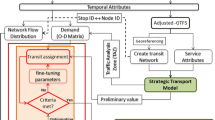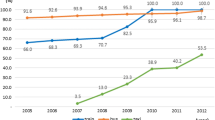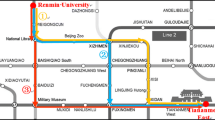Abstract
The accuracy of transit assignment plays an important role in the successful design and operation of a transit system. The majority of previous studies on validating transit assignment models has used limited survey data or has lacked a large-scale multimodal and high quality dataset. Considering the advantages of smart card [automatic fare collection (AFC)] systems, the aims of this study are to put forward a methodological framework to validate existing transit assignment models and to quantify the performance of these models. Our study combines data from three sources: the General Transit Feed Specification, an AFC system, and a strategic transport model from a large-scale multimodal public transport network, namely the South-East Queensland (SEQ) network in Australia. The AFC system in SEQ has provided a very large and highly accurate dataset on passenger boardings and alightings for the three transit modes of bus, rail and ferry. Following a data analysis, an origin–destination trip matrix is estimated for the AM peak period using AFC data as an input to the transit assignment model. Then, the results of the transit assignment model are compared with the actual passengers’ route choices over the same period, at different levels of aggregation. The model performance is quantified by each route (and direction), by each segment of each route (and direction), and by each stop. The results indicate that relatively tighter thresholds are required to validate the transit assignment at the segment level than at the stop level. Furthermore, the validation results indicate that the greatest error is realized for the bus mode, while the level of accuracy in the rail mode is the best. The results suggest a segment-level analysis should be used as the most useful level of aggregation for future calibration and validation of transit assignment models.







Similar content being viewed by others
References
Alsger AA, Mesbah M, Ferreira L, Safi H (2015) Use of smart card fare data to estimate public transport origin-destination matrix. Transportation research record. J Transp Res Board 2535:88–96
Alsger A, Tavassoli A, Mesbah M, Ferreira L (2017) Evaluation of effects from sample-size origin-destination estimation using smart card fare data. J Transp Eng Part A Syst 143(4):04017003
Caliper (2015) Transcad transportation planning software user’s guide version 7. Caliper Corporation, Newton
Cambridge Systematics (2010) Travel model validation and reasonableness checking manual, vol 2. Federal Highway Administration, Washington, DC
Cepeda M, Cominetti R, Florian M (2006) A frequency-based assignment model for congested transit networks with strict capacity constraints: characterization and computation of equilibria. Transp Res Part B Methodol 40(6):437–459
Childs C (2004) Interpolating surfaces in arcgis spatial analyst. ArcUser, July–September, p 3235
Desaulniers G, Hickman M (2007) Chapter 2 public transit. In: Barnhart C, Laporte G (eds) Handbooks in operations research and management science. Elsevier, Amsterdam, pp 69–127
Dial RB (1967) Transit pathfinder algorithm. Highw Res Rec 205:67–85
ESRI (2015) Arcgis 10.3 for desktop. Environmental Systems Research Institute, Redlands
Fung S, Tong C, Wong S (2005) Validation of a conventional metro network model using real data. J Intell Transp Syst 9(2):69–79
Google (2013) General transit feed specification reference [Online]. https://developers.google.com/transit/gtfs/. Accessed 20 Feb 2014
Hensher DA, Button KJ (2008) Handbook of transport modelling, 2nd edn. Elsevier, Amsterdam, Oxford
Hickman MD, Bernstein DH (1997) Transit service and path choice models in stochastic and time-dependent networks. Transp Sci 31(2):129–146
INRO (2015) Emme user’s manual software version 4.2. INRO Consultants Incorporated, Montreal
Kusakabe T, Asakura Y (2014) Behavioural data mining of transit smart card data: a data fusion approach. Transp Res Part C Emerg Technol 46:179–191
Lam WH-K, Gao Z, Chan K, Yang H (1999) A stochastic user equilibrium assignment model for congested transit networks. Transp Res Part B Methodol 33(5):351–368
Liu Y, Bunker J, Ferreira L (2010) Transit users’ route-choice modelling in transit assignment: a review. Transp Rev 30(6):753–769
Moore T (2015) Queensland seeks next go card revolution [Online]. http://www.brisbanetimes.com.au/queensland/queensland-seeks-next-go-card-revolution-20150925-gjv9ip.html. Accessed 12 Mar 2015
Munizaga M, Devillaine F, Navarrete C, Silva D (2014) Validating travel behavior estimated from smartcard data. Transp Res Part C Emerg Technol 44:70–79
MWH (2009) Transport and traffic summary technical analysis, Appendix E. Department of Transport and Main Roads, Queensland Government, Queensland
Nassir N, Khani A, Lee S, Noh H, Hickman M (2011) Transit stop-level origin-destination estimation through use of transit schedule and automated data collection system. Transp Res Rec J Transp Res Board 2263:140–150
Nassir N, Hickman M, Ma Z-L (2015) Activity detection and transfer identification for public transit fare card data. Transportation 42(4):683–705
Nassir N, Hickman M, Ma ZL (2017) Statistical inference of transit passenger boarding strategies from Farecard Data. In: TRB 96th annual meeting compendium of papers. Transportation Research Board, Washington, D.C
National Cooperative Highway Research Program (2012) Travel demand forecasting: parameters and techniques, NCHRP Report 716, Transportation Research Board
Nielsen OA (2000) A stochastic transit assignment model considering differences in passengers utility functions. Transp Res Part B Methodol 34(5):377–402
Nuzzolo A, Crisalli U, Rosati L (2012) A schedule-based assignment model with explicit capacity constraints for congested transit networks. Transp Res Part C Emerg Technol 20(1):16–33
Pelletier M-P, Trépanier M, Morency C (2011) Smart card data use in public transit: a literature review. Transp Res Part C Emerg Technol 19(4):557–568
Pitney B (2015) Mapinfo professional user’s manual software version 15, Pitney Bowes Software Inc
Poon MH, Tong CO, Wong SC (2004) Validation of a schedule-based capacity restraint transit assignment model for a large-scale network. J Adv Transp 38(1):5–26
Queensland Government (2013) General Transit Feed Specification (GTFS)—South East Queensland [Online]. https://data.qld.gov.au/dataset/general-transit-feed-specification-gtfs-seq. Accessed 20 Feb 2014
Resource Systems Group (2013) Improving existing travel models and forecasting processes: a white paper, FHWA-HEP-14-019, Federal Highway Administration, https://www.fhwa.dot.gov/planning/tmip/publications/other_reports/improving_existing_models/improvingexistingtravelmodels.pdf. Accessed 20 Mar 2015
Robinson S, Narayanan B, Toh N, Pereira F (2014) Methods for pre-processing smartcard data to improve data quality. Transp Res Part C Emerg Technol 49:43–58
Ryan M (2008) BSTM Multi-Modal Model Development, Trip Assignment, Working Paper 15, Queensland Government-Department of Transport and Main Roads, Brisbane, Australia
Slavin H, Rabinowicz A, Brandon J, Flammia G, Freimer R (2009) Using automated fare collection data, GIS, and dynamic schedule queries to improve transit data and transit assignment model. Schedule-based modeling of transportation networks: Theory and applications. Springer, Boston
Smith M, Sadek A, Huang S (2008) Large-scale microscopic simulation: toward an increased resolution of transportation models. J Transp Eng 134(7):273–281
Spiegelman CH, Park ES, Rilett LR (2011) Transportation statistics and microsimulation. Chapman & Hall/CRC, Boca Raton
Spiess H, Florian M (1989) Optimal strategies: a new assignment model for transit networks. Transp Res Part B Methodol 23(2):83–102
Sun L, Lu Y, Jin JG, Lee D-H, Axhausen KW (2015) An integrated Bayesian approach for passenger flow assignment in metro networks. Transp Res Part C Emerg Technol 52:116–131
Tong C, Wong S (1998) A stochastic transit assignment model using a dynamic schedule-based network. Transp Res Part B Methodol 33(2):107–121
Trépanier M, Tranchant N, Chapleau R (2007) Individual trip destination estimation in a transit smart card automated fare collection system. J Intell Transp Syst 11(1):1–14
Vlahogianni EI, Park BB, Van Lint J (2015) Big data in transportation and traffic engineering. Transp Res Part C Emerg Technol 58:161
Vuk G, Hansen CO (2006) Validating the passenger traffic model for Copenhagen. Transportation 33(4):371–392
Wahba M, Shalaby A (2006) Milatras: a microsimulation platform for testing transit-ITS policies and technologies. In: 2006 IEEE intelligent transportation systems conference
Washington S, Karlaftis MG, Mannering FL (2011) Statistical and econometric methods for transportation data analysis. CRC Press, Boca Raton
Zhao J (2004) The planning and analysis implications of automated data collection systems: rail transit OD matrix inference and path choice modeling examples, Massachusetts Institute of Technology
Acknowledgements
The authors would like to acknowledge TransLink for providing the AFC data for this research. We would also like to acknowledge the Queensland Department of Transport and Main Roads (DTMR), Transport Strategy and Planning Branch, for providing access to the South East Queensland Strategic Transport Model (SEQSTM). This work is partially supported by the Transport Academic Partnership between DTMR and the University of Queensland, and by the Australian Research Council through a DECRA Grant (Grant number: DE2015002743).
Author information
Authors and Affiliations
Corresponding author
Rights and permissions
About this article
Cite this article
Tavassoli, A., Mesbah, M. & Hickman, M. Application of smart card data in validating a large-scale multi-modal transit assignment model. Public Transp 10, 1–21 (2018). https://doi.org/10.1007/s12469-017-0171-1
Accepted:
Published:
Issue Date:
DOI: https://doi.org/10.1007/s12469-017-0171-1




